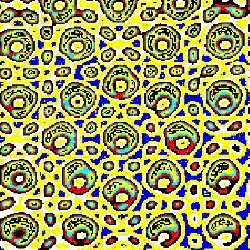Catch a Quasiperiodic Wave

Quasicrystals are unusual metallic alloys whose atoms are arranged in orderly patterns that are not quite crystalline. One of the many mysteries surrounding these materials is how to describe the motion of electrons inside them. Previous work has suggested that Bloch-like waves–which describe electron motion in classic crystals–can occur in quasicrystals as well. In the 21 March print issue of PRL, researchers strengthen this case by showing Bloch-like liquid surface waves in a pool with a quasiperiodic floor pattern. This is the first time such waves have been seen in a fluid.
Periodic patterns are easy to visualize. A floor tiled with squares or hexagons is periodic–you could pick the pattern up, slide it over a unit or two, and lay it back down over its original lines. Quasiperiodic patterns, though, are odd creatures. At first glance, they look periodic–bits of the same pattern show up over and over, and the patterns have local rotational symmetries, like a pentagon. But they never quite repeat.
When electrons move through crystalline materials, which have periodically arranged atoms, their motion can be described mathematically by Bloch functions. These functions describe the wavelike nature of the electrons and include the periodicity of the underlying material. But there’s no such simple rule for electron motion in quasicrystals. A recent experiment mapped out electron energies in a quasicrystal and suggested that the electrons might follow Bloch-like waves, but the phenomenon is still not fully understood.
In their new study, José-Luis Aragón, of the National Autonomous University of Mexico, and his colleagues, looked at the problem from a different angle: they examined quasiperiodic liquid waves. They drilled small depressions in the bottom of a shallow, fluid-filled octagonal pan, at the vertices of a quasiperiodic pattern. Vibrating the pan vertically at 35 vibrations per second caused the fluid to form a quasiperiodic standing-wave pattern. Then the researchers sent a quick, transverse wave pulse across the fluid. The traveling wave going through the quasiperiodic pattern is analogous to an electron wave traversing a quasiperiodic material.
The team found that the traveling wave pulse created a Bloch-like state–a wave pattern related to the underlying quasiperiodic pattern. The spacing between the wave peaks was not constant, as in a periodic wave, but varied quasiperiodically between two values, which were related to the spacings in the pattern on the pan’s bottom.
Patricia Thiel of Iowa State University in Ames says that the work complements previous experiments with quasicrystals. “It has a major relationship to the long-standing question of ‘How do electrons move in materials that don’t have periodicity?’” she says. “The beauty of this paper is that with these very elegant and simple experiments they’ve provided a way to visualize how these effects can occur. It’s just a lovely experiment.”
–Lea Winerman
Lea Winerman is a freelance science writer.


